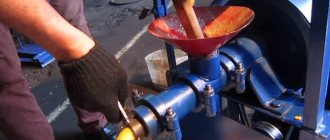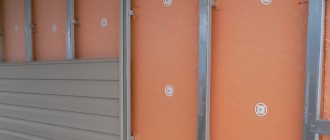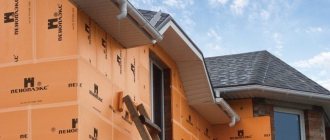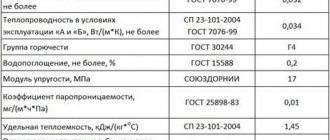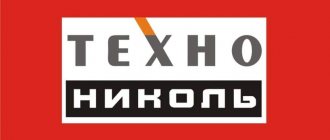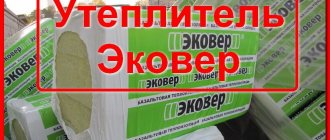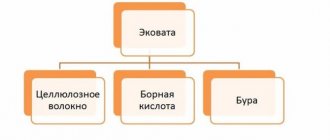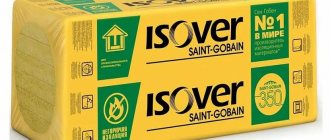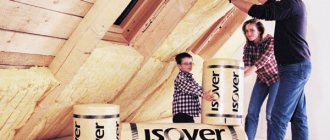An example of the successful use of polystyrene foam. Super lightweight and easy to process, foam plastic is often used by modern sculptors to create bas-reliefs or mobile statues.
There is no universal insulation; each one is selected for the task. It's the same story with polystyrene foam. If you use it in certain cases and according to technology, it will show all its advantages and the result will be excellent.
Thermal conductivity
EPS and EPS have low, and therefore good, thermal conductivity. The extruder, due to its denser structure, is slightly ahead in this parameter. A 50 mm sheet insulates a room better than a half-meter thick concrete wall. This is an effective material, on par with mineral wool.
Note: UV protection and adhesion
Polystyrene foam is afraid of ultraviolet radiation. It must be covered with another material on top: plaster, if we are talking about a facade, or a roofing covering together with a waterproofing membrane, if the roof is insulated.
EPS and EPS are very smooth, so in order to improve the surface in terms of adhesion, before applying the glue, you need to damage the top layer with very rough sandpaper or scratch it with a hacksaw. Otherwise, over time, the plaster will slip and fall off.
Another reliable option is to glue a reinforced mesh onto the insulation with alkaline glue, and then apply plaster on it.
The difference between EP and polystyrene foam
The difference between EP and polystyrene foam.
What is the difference between EP and ordinary polystyrene foam?
- The EP has a uniform structure and consists of small closed cells. Thanks to this structure, it can guarantee minimal water absorption. Its structure does not allow the circulation of water and steam. It differs from ordinary polystyrene in that it can maintain its thermal insulation properties for a long time. If this material is used, the heating level of the room can be reduced, which becomes a significant saving.
- Ordinary polystyrene foam is weaker than EP, this has been proven in practice. EP is capable of withstanding loads of more than 60 tons per m3. Therefore, this material is recommended for use where it is necessary to make a coating of increased strength. And in terms of cost, this material is cheaper than conventional polystyrene foam or other thermal insulation materials.
Flammability class and combustion toxicity
Opponents of foam plastics in construction, first of all, talk about their flammability and toxicity. Let's figure out how dangerous this is.
If the mineral wool does not burn at all (class NG), then the foam plastic and the extruder do burn. EPS and EPS can be of 4 flammability classes:
- G1 - low
- G2 - moderate
- G3 - average
- G4 - increased
The first and second classes die out within a few seconds as soon as the direct source of fire disappears. Additionally, special additives are used to prevent the formation of flammable droplets - fire retardants; they reduce the access of oxygen during combustion. EPS flares up, but does not support combustion, but EPS burns, so its class is third and fourth.
It turns out that foam plastic marked G1 and G2 can be used to insulate residential buildings and apartments, but what about the extruder with its G3 and G4?
An extruder is perfect for:
- for insulation of damp and cold rooms,
- floors and pipes,
- basement and basement,
- foundation and blind area,
- garden paths,
- flat inversion roofing,
- stylobate and parking,
- balconies and loggias,
- highways,
- and even the runway.
EPS can be used in contact with the ground; it can withstand large temperature changes and prevent concrete from freezing.
Hazardous material in construction – expanded polystyrene
FOAM POLYSTYRENE
The rapid development of the chemical industry coincided with the Cold War era. New defense and attack systems required adequate heat and sound insulation materials. They had to be distinguished, in particular, by their efficiency, ease of manufacture, ease of use, lightness, and low thermal conductivity. The military order was successfully completed. Polymer insulation materials have appeared, including expanded polystyrene.
Thermoformed polystyrene foam (GOST 15588–86) is widely used in the construction and packaging industries. Expanded polystyrene (EPS) is a gas-filled foam plastic based on polystyrene (PS). In modern production, foaming of PS is carried out mainly through the use of high-boiling liquids (isopentane, methylene chloride, etc.), which are introduced into polystyrene “beads” during the polymerization of styrene (S). When heated, for example, in hot water, the beads foam, forming pre-foamed granules, which, after drying and aging, are sintered into volumetric blocks at temperatures of 140-170°C and pressures of 150-200 KGS/cm2. The blocks are then cut to the required dimensions. The industry also uses extruded polystyrene foam with a continuous production method (PPS).
It is no secret that war and comfort are “incompatible things.” Therefore, when the material proved its commercial value in the mass solution of energy saving problems in the civil sphere, complete information about it became dangerous for the core business.
Therefore, foam plastic, a light and warm to the touch material, consisting of 98% air, given to us half a century ago by chemists and called polystyrene foam, is widely used in the construction of various technological buildings, residential buildings, the panel walls of which look like a pie with a chemical filling or with thermoblocks made of foam polystyrene placed on a wall made of monolithic reinforced concrete from the outside and inside. Such a house is proudly called “THERMODOM”.
To promote the use of expanded polystyrene in construction, many myths are assigned to it:
Myth one:
High thermal insulation properties .
Thermal insulators according to the criterion of thermal conductivity. Most foam plastic insulation typically has a thermal conductivity of 0.035–0.048 W/mK at 25°C. Some manufacturers claim that this figure reaches values of 0.020 W/mK and even 0.018 W/mK. But foamed plastics are characterized by water absorption . Thus, granulated polystyrene foam made using the non-press method increases its water absorption up to 350% by weight. But this is not the limit. Cases have been recorded when slabs of non-pressed polystyrene foam, when operating a coating with a damaged waterproofing carpet, acquire a humidity of up to 900%. It is clear that with such an amount of absorbed water, there can be no question of any standard value for the thermal conductivity coefficient of the thermal insulation material.
Within an hour, a person releases about 100 g of moisture. If this is a living space, then to this amount it is necessary to add moisture that appears during cooking, washing, etc., as a result of which the humidity increases many times over. Therefore, to create a comfortable and healthy microclimate, external walls must “breathe,” which means they have good vapor permeability. However, the vapor permeability of absolutely all foam insulation materials used in construction is an order of magnitude less than that of mineral wool and fiberglass insulation. For example, the vapor permeability coefficient of polyurethane foam and polystyrene foam is approximately 0.05 mg/mchPa, while for mineral wool products it is 0.4–0.6 mg/mchPa. Therefore, as shown by the results of studies conducted by the Frankfurt Institute of Building Physics and the Hanover Institute of Building Technology, the use of polystyrene foam boards as insulation reduces the diffusion of water vapor through external walls by an average of 55–57%. The Technical University in Helsinki monitored microclimate parameters in St. Petersburg houses insulated with polystyrene foam. In these houses, old, traditional Soviet-made windows were replaced with new, modern ones with double-glazed windows and ventilation valves, ventilation was restored, and a coolant temperature control system was installed. However, in the first winter, the relative air humidity in 70% of apartments reached 80% at an air temperature of 18°C, and such conditions are very favorable for the development of fungi.
Myth two:
Durable material .
This property was the reason for a closer study of the properties of many thermal insulation materials, including expanded polystyrene. Particularly in-depth research was carried out by the laboratory of Professor A. I. Ananyev at the Research Institute of Construction Physics (Moscow). The reason for the research was the results of opening the covering of an underground shopping complex on Manezhnaya Square in Moscow, built several years ago. When opening the coating, which had been in operation for only two years, significant destruction of the polystyrene foam boards was discovered, on which significant holes and cracks had formed. As a result of destruction processes, the thickness of some slabs decreased by 80–14 mm, while the density of polystyrene foam in the thinnest part increased more than fourfold - to 120 kg/m3. The reduced heat transfer resistance of the thermal insulation layer of the coating in the zone of excessive destruction of polystyrene foam boards became 0.32 square meters. m°C/W, which differs from the design value of 2.7 sq. m°C/W, more than eight times. The reason for such a catastrophic state of the insulation was, as research results showed, a violation of the work technology and the lack of taking into account a number of physical and chemical features of expanded polystyrene during design. The same laboratory carried out studies of non-pressed polystyrene foam, which was used, so to speak, in more ordinary conditions - external building envelopes. The results showed a fairly significant increase (0.047–0.05 W/m°C) in the thermal conductivity of the insulation. High convergence with the results of NIISF is shown by studies conducted by the Nizhny Novgorod State University of Architecture and Civil Engineering. The data obtained there show that the reduced value of the heat transfer resistance of external walls insulated with non-pressed polystyrene foam decreased by an average of 49–59%.
The head of the laboratory of the Russian Research Institute of Building Physics, Doctor of Technical Sciences Alexander ANANEV and Chairman of the Board of the Russian Society of Civil Engineers (ROIS), Doctor of Technical Sciences Oleg LOBOV recorded cases when, over seven to ten years of operation of structures, the ability of polystyrene foam to retain heat decreased threefold. This, in their opinion, happens because, in addition to the process of natural destruction, other factors are also at work: for example, apartment renovations, careless handling of household chemicals by residents. It does not tolerate polystyrene foam and volatile hydrocarbon compounds well (they appear when the facade is painted or covered with waterproofing).
The reckless use of polymers, according to Russian professor Boris BATALIN, who has devoted forty years to the study of building materials, can lead to the fact that momentary savings will subsequently result in multi-billion dollar costs. It has been proven that after 10-15 years, expanded polystyrene will inevitably age and its heat-shielding properties will deteriorate. This means that twice as much heat will be needed to heat houses.
From this point of view, extruded polystyrene foam (EPS) is more effective, which, as shown by modeling results at VNIIstroypolymer, can withstand 50-year cyclic temperature and humidity loads, but only if used in the subgrade (underlayment of the road surface) and for insulation of basements. These data are indirectly confirmed by the results of a survey carried out by the Belarusian National Technical University. Structures built in 1976, in the enclosing structures of which extruded polystyrene foam was used, were subjected to examination. For laboratory tests, control samples were taken, the results of which showed that the insulation was in excellent condition. We emphasize that extruded polystyrene foam is used in the West as insulation located in the ground - mainly under the road surface of highways or artificial reservoirs, i.e. where it is not exposed to water vapor.
Myth three:
Eco-friendly material .
There are especially many complaints about polystyrene-based materials due to the release of harmful substances. The fact is that, firstly, 100% polymerization occurs only theoretically. In fact, this never happens with polystyrene; the polymerization process does not go to completion, at 97–98%; secondly, the polymerization process is reversible, so polymers constantly decompose under the influence of light, oxygen, ozone, water, mechanical and ionizing influences, and especially under the influence of heat. The free styrene formed in this way penetrates into the premises, and people live for a long time in an environment where there is styrene in the living atmosphere (even if the concentration is below the MPC). The heart suffers from these microdoses of styrene, and special problems arise in women. Styrene has a strong effect on the liver, causing, among other things, toxic hepatitis.
The main toxicological hazard of polystyrene (PS) and expanded polystyrene (EPS), respectively, is that PS is an equilibrium polymer that, under normal operating conditions, is subject to depolymerization and, as a result, already under normal operating conditions is in thermodynamic equilibrium with its highly toxic monomer, styrene. (C): PS n = PS n-1 + C .
If the thermodynamic equilibrium of polystyrene shifts to the right, therefore, styrene is constantly released into the environment. The presence of thermodynamic equilibrium of polystyrene has been proven experimentally. The concentration of C in PS depends on temperature (an increase in temperature causes an increase in the concentration of C). At a temperature of 25°C, the concentration of C in PS is 10.6 Kmol/m3. Since one Kmol of PS is 104 grams, then at 25°C 1 m3 of polystyrene foam will contain 104 micrograms of styrene, which is very much considering the MPC value (linear concept) for developed countries. Their maximum permissible concentration of styrene is 0.002 mg/m3 for the air of populated areas and premises!!!
Research in Minsk has shown that even at room temperature, samples of insulation systems with thin-layer plasters and thermal insulation made of domestically produced polystyrene foam emit an unacceptably large amount of styrene (exceeding the maximum permissible concentration by 3.7–10.1 times). And at 80 degrees (the outer layers of the wall can heat up to this temperature in summer), a 169-fold excess was recorded! The “naked” sample of expanded polystyrene at the same 80 degrees produced styrene in an amount of 525 MPC.
The foam is also subject to weathering, during which gas-containing mixtures appear in small concentrations. If they affect the body of a child or a sick person for a long time, they will certainly cause protracted and incomprehensible illnesses. In Western countries, all these persistent organic pollutants (POPs) are subject to a special ban under the Stockholm Convention.
Corresponding Member of the Russian Academy of Sciences Boris Gusev and his colleagues discovered that during the period of operation, up to 10–15% of polystyrene foam decomposes, and the decomposed part is 65% styrene. And it has increased cumulative properties - it accumulates in the liver, but is not excreted. This means, scientists believe, it is necessary to reduce the maximum permissible concentration of styrene released into housing by a factor of 600. It turns out that this substance cannot be used in the housing sector at all.
REFERENCE INFORMATION
Maximum permissible concentration (MPC)
Speaking about such a parameter as the maximum permissible concentration, it is necessary to mention that there are two concepts for assessing the effect of harmful substances on the human body - threshold and linear . The threshold concept states that it is necessary to reduce the concentrations of harmful substances to a certain level (threshold), determined by the value of the maximum permissible concentration (MAC). Small concentrations (below the MPC level) of harmful substances are harmless. This concept is followed in Russia and the countries of the former USSR. The linear concept assumes that the harmful effect on a person depends proportionally (linearly) on the total amount of the substance absorbed, that is, on the product of its concentration and time. Hence the conclusion: Low concentrations with long-term consumption are harmful. This concept is actually adhered to by a number of countries: the USA, Germany, Canada, Belgium, Japan and some others. The transition to a linear concept will force us to reconsider many standards. For example, the MPC value for sulfur dioxide should be reduced by 6.2 times, and for styrene – by 594 (!) times. Such a low required MPC value for styrene indoors is caused by the special properties of styrene. This substance belongs to condensed aromatic compounds that have one or more benzene nuclei in their molecule, and, like similar substances (benzene, benzpyrene, benzanthracene), has increased cumulative properties: it accumulates in the liver and is not excreted.
The conclusions of our environmental researchers are very categorical. Firstly, it is necessary to revise the MPC standards, which for housing construction should be reduced tens and hundreds of times in accordance with the cumulative properties of harmful materials. Secondly, according to scientists, among the substances contained in building materials, styrene has the highest degree of cumulativeness, which requires reducing the maximum permissible concentration for its use in housing construction to such minimum values that this is tantamount to a complete ban on the use of styrene polymerization products in housing construction in general .
But that's not all. The oxidation of styrene with atmospheric oxygen produces benzaldehyde and formaldehyde . At high temperatures (from 160°C and above), polystyrene foam undergoes intense thermal-oxidative destruction, decomposing mainly into highly toxic styrene, severely poisoning the environment and people, which is what happens during fires in buildings insulated with EPS. In addition, during fires, EPS melts and its melt burns, and the temperature of the burning EPS alloy reaches 1100°C, which leads to the destruction of even powerful metal structures. It is precisely because of the high combustion temperature of PPS that it is used as the main component in napalm bombs, which are used, among other things, to destroy enemy armored vehicles!!! Because of these properties of PPS, it was categorically banned for use as insulation in railway cars more than 15 years ago. In the works of NPO "VNIISTROYPOLIMER" on the sanitary-chemical assessment of various building structures of insulated PPS, carried out in the 70s..80s of the last century, it was shown that none of the presented structures can be used in the construction of residential buildings. The reason for this was the excess of the actual C content in the air over the MPCSS value for C. In the 90s, the so-called expanded polystyrene concrete, which was supposed to be poured into hollow structures, received a negative conclusion. Excess of C concentrations by 2-4 times above the MPCSS level.
REFERENCE INFORMATION
Styrene (vinylbenzene, phenylethylene) is an unsaturated aromatic hydrocarbon , C6H5CH=CH2, a colorless liquid with a specific odor, density 0.906 g/cm3, boiling point 145.2°C.
Styrene monomer is used in the production of polystyrene (including impact polystyrene and expanded polystyrene), ABS plastics, buta-styrene rubbers, thermoplastic elastomers, copolymers with acrylonitrile, vinyl chloride; copolymers with divinylbenzene - raw materials for ion exchange resins; reactive solvent for polyester resins, modifier for alkyd resins.
Causes irritation of the mucous membranes of the upper respiratory tract, headache, disorder of the central and autonomic nervous system. The maximum permissible concentration is 5 mg/m3 (limit concept), and 0.002 mg/m3 (linear concept). Styrene has a negative effect on human blood, causing leukemia, has a negative effect on the liver, and can cause toxic hepatitis. A particular danger of styrene is that it has an embryogenic effect, that is, with prolonged exposure it causes deformation of the embryo in the womb (see the works of Professor A.N. Bokov, in the works of the Department of Hygiene and Toxicology of Polymer Materials of the Rostov Medical Institute).
It is a well-known fact: the majority of young women who lived on the BAM in mobile houses (and they were insulated with polystyrene foam) lost the ability to bear children. And in Belarus, in houses with similar insulation, children under 14 years old get sick five to six times more often than in ordinary houses.
In addition, styrene has another very dangerous property - a high coefficient of cumulativeness (accumulation), that is, a pronounced ability to accumulate (concentrate) in the human body. As proof, we present a table of cumulative coefficients for a number of harmful substances released from polymer building materials:
Cumulative coefficients for a number of harmful substances
| Substance | Coefficient Cumulativity |
| Carbon monoxide | 0,1195 |
| Nitrogen dioxide | 0,1760 |
| Phenol | 0,2815 |
| Formaldehyde | 0,5750 |
| Benzene | 0,6330 |
| Styrene | 0,7005 |
Thus, even if the styrene content in indoor air is at the MPCSS level (0.002 mg/m3), it will have a strong toxic effect on the human body due to cumulation (accumulation).
Polystyrene is a product of the polymerization of styrene (vinylbenzene). Polystyrene is a hard, elastic, colorless substance. It is a rigid, amorphous polymer with low mechanical tensile and bending strength. Polystyrene has low density, thermal stability, excellent dielectric properties and very low impact strength. It is easily deformed at relatively low temperatures (80°C).
Plastics are produced from polystyrene, which are widely used in the electrical industry, for the manufacture of household items (dishes, figurines, children's toys, etc.), lenses, facing tiles and permanent formwork (thermal blocks) for construction, etc.
CONCLUSION
Thus, the use of expanded polystyrene in the construction of residential buildings, be it permanent formwork, internal or partition insulation, sandwich panels (OSB board - expanded polystyrene - OSB board), should be completely prohibited . Structures using expanded polystyrene are real “gas chambers” for people and pose an extremely high fire hazard. In the event of a fire, the chances of saving people are minimal.
The use of expanded polystyrene in any form during the construction of residential buildings should be considered an environmental crime against citizens of the Russian Federation!!!
But according to the conclusion of the State Committee for Sanitary and Epidemiological Surveillance of the Russian Federation, the material is considered absolutely harmless. Moreover, the Moscow Research Institute of Hygiene named after. F.F. Erisman conducted studies of air samples from rooms for which polystyrene foam was used for insulation; substances harmful to humans, including styrene, were not detected. Consequently, polystyrene boards are approved for use in insulating food containers and as insulation boards for homes.
But ask yourself 2 questions (as the residents of Ukraine do):
1. What good is expanded polystyrene for us, taking into account global experience and trends?
2. Isn’t it worth thinking hard not only about the health of the living, but also about the health of people who have not yet been born?
In conclusion, let us quote the expression of the former Kyiv mayor Vladimir GUSEV: “The more we build panel houses, the more hospitals we will have to build.”
However, it is naive to hope for a quick closure of the oil-based production of polystyrene foam, which is disgracing itself in the eyes of consumers. By hook or by crook, this material will be imposed on the whole world for as long as possible. But if mercantile interests are above all, expect trouble.
PROTECTION
About 12 years ago, polystyrene concrete began to be actively promoted, in which pre-expanded polystyrene granules were mixed into ordinary concrete mortar.
The Research Institute "Reinforced Concrete" submitted this material for examination to the Moscow SES, and it stopped using it in residential and public buildings due to emissions of styrene, a substance dangerous to humans. It was found that at room temperature the release of styrene exceeds the maximum permissible concentration by 2.5 times, and at a temperature of 40ºC the excess of the maximum permissible concentration is 3-4 times.
Then the Research Institute “Reinforced Concrete” turned to Academician V.V. Maltsev. find a means to eliminate emissions of harmful volatiles from polystyrene concrete. An agreement was concluded and a solution was found.
This solution was the protective primer “ STIRODET ”.
After treating with this primer, the premises were re-inspected by the Moscow SES, and it gave the go-ahead for the use of polystyrene concrete.
Therefore, those who permanently live in houses with polystyrene foam or polystyrene concrete insulation strongly recommend the use of this primer.
LITERATURE:
- Encyclopedia of polymers, vol. 2 - M.: ed. "Soviet Encyclopedia", 1974
- Slonim I.Ya. Urman Ya.G. book NMR - spectrometry of heterogeneous polymers, M., 1982.
- Chemical Encyclopedia, vol. 5 - M., ed. "Great Russian Encyclopedia", 1997
- USSR Ministry of Health, Main Sanitary and Epidemiological Directorate. “Maximum permissible concentrations (MPC) of pollutants in the atmospheric air of populated areas - M., 1984.
- “Harmful substances in industry” vol. 1 – Leningrad, ed. "Chemistry", Leningrad branch, 1976
Water absorption and vapor permeability
The water absorption of EPS is worse than that of EPS. This means that the foam will need an additional waterproofing membrane to prevent the material from picking up water.
The vapor permeability of EPS is higher than that of EPS. In this sense, the material “breathes”, although not as well as mineral wool, but it is often used in country house construction.
The extruder performance in both cases tends to zero.
The lack of vapor permeability will be a disadvantage only if you insulate the walls or roof and do not install a ventilation system in the house. Mold and mildew are not a consequence of poor material, but the result of improper installation of insulation.
The lack of water absorption is a definite plus, given the areas of application of the material: wet soil, pipes, basements.
Advantages of extruded polystyrene
Among the main advantages of EP are the following:
- This material has no water absorption;
- It has low thermal conductivity;
- The material is harmless to humans and the environment;
- Has low vapor permeability;
- It is biologically stable or not subject to decomposition;
- Its properties remain unchanged at temperatures from -50 (for some manufacturers -75) to +75 ° C;
- The slabs do not lose their properties when defrosted and frozen more than 1000 times;
- Thanks to special additives, the material is not subject to combustion and prevents the spread of flame;
- The material is not exposed to various microorganisms: bacteria, fungi;
- Due to its excellent adhesion to other building materials, EP will not be subject to various damages and corrosion;
- The material is easy to use, it is attached to the walls using special glue and corners with strips;
- Its service life is more than 50 years;
- EP 100 mm has exceptional properties, therefore it is used at large industrial facilities.
Intended use
Large manufacturers of EPS and EPS, such as URSA, KNAUF and TechnoNIKOL, in addition to certificates, accompany their materials with detailed instructions on how and where to use them correctly.
Extruded polystyrene foam URSA XPS
TechnoNIKOL XPS carbon
